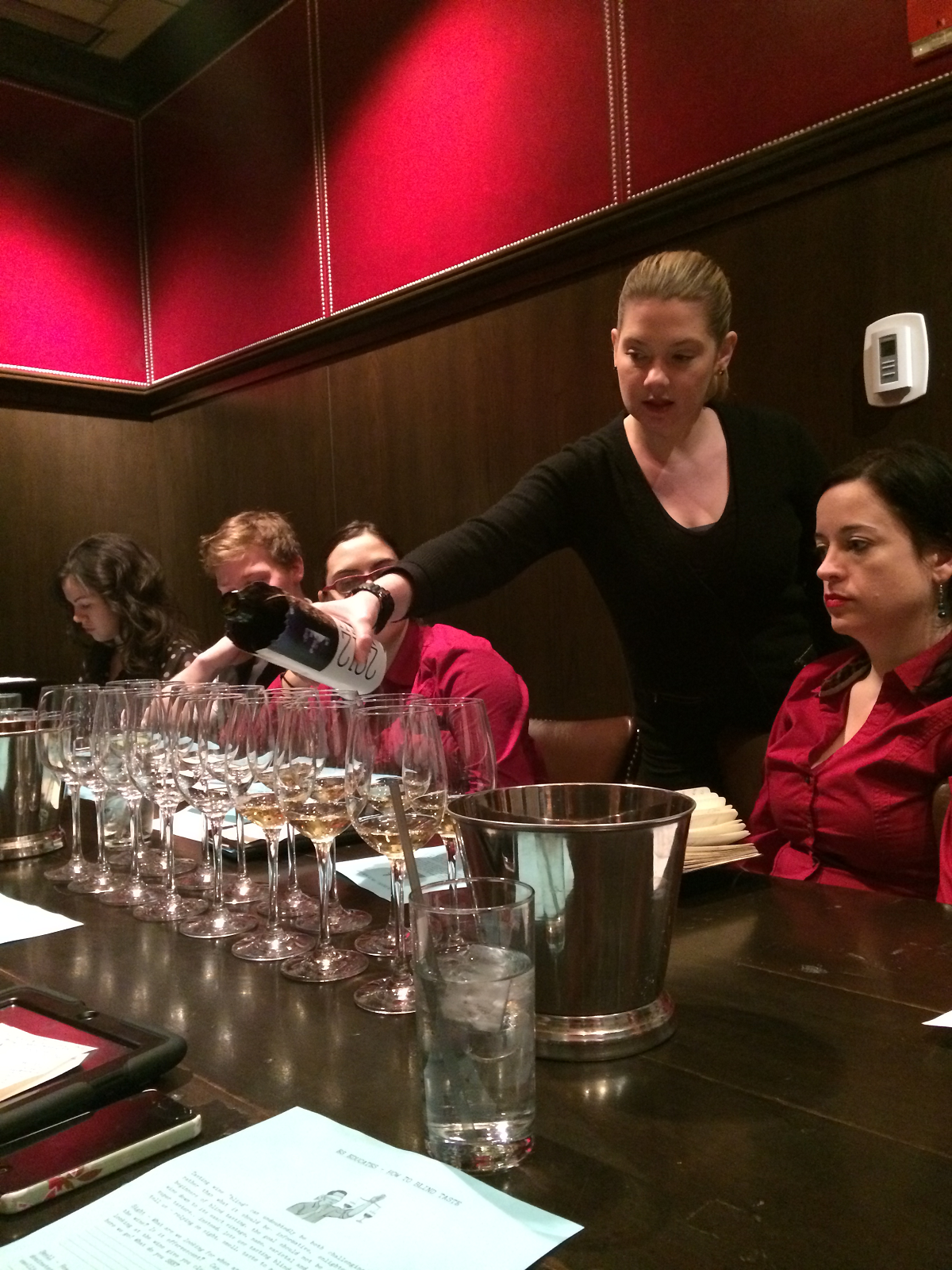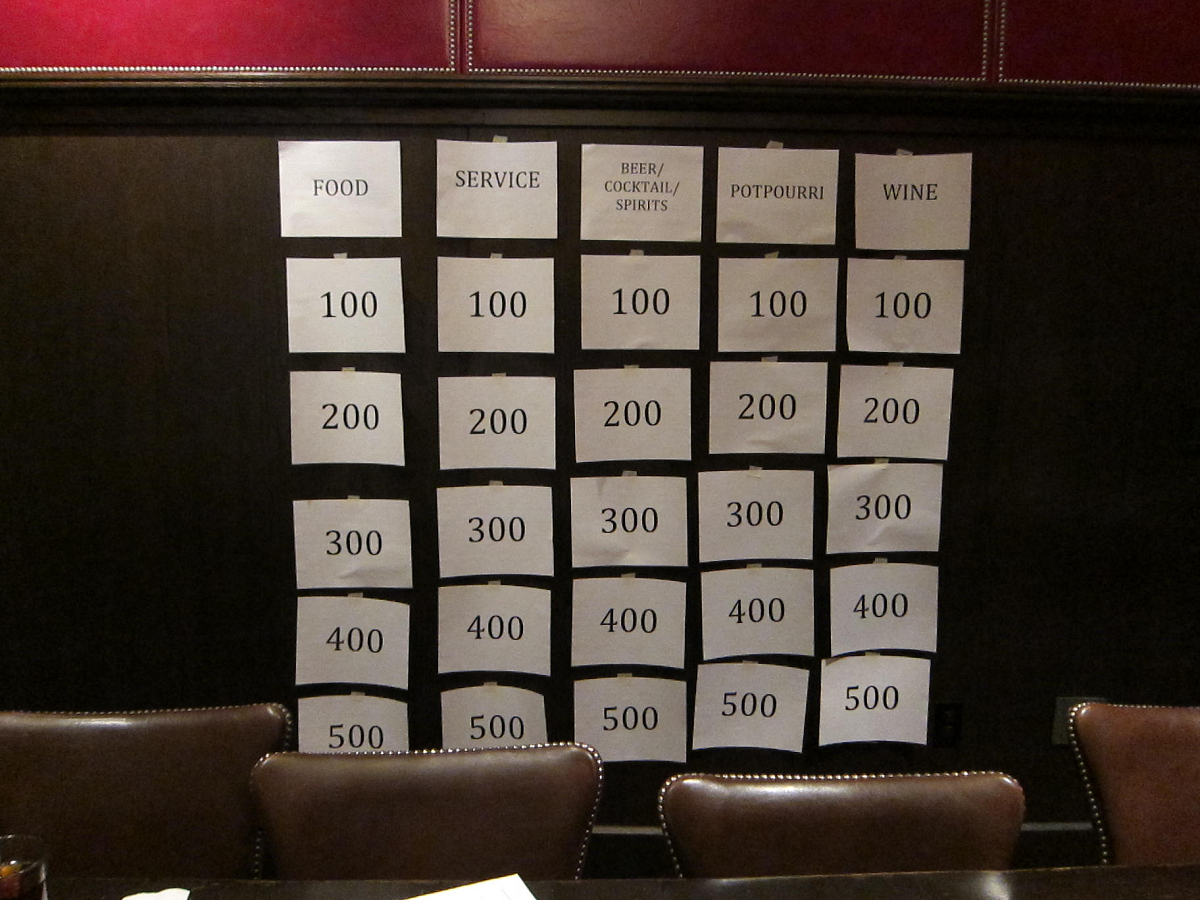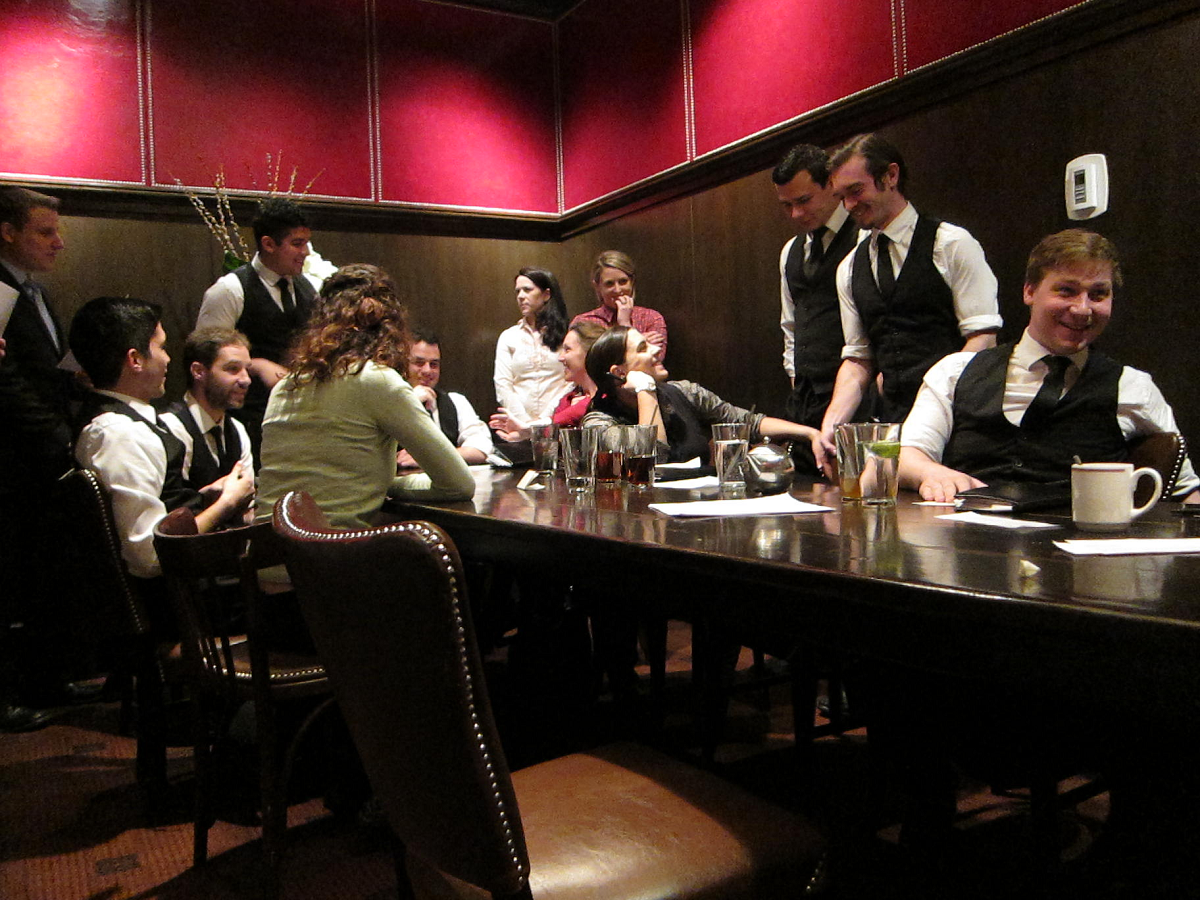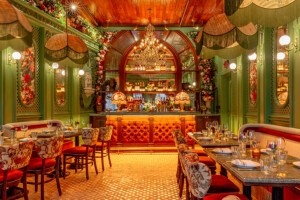What I Learned During a Week at Eastern Standard
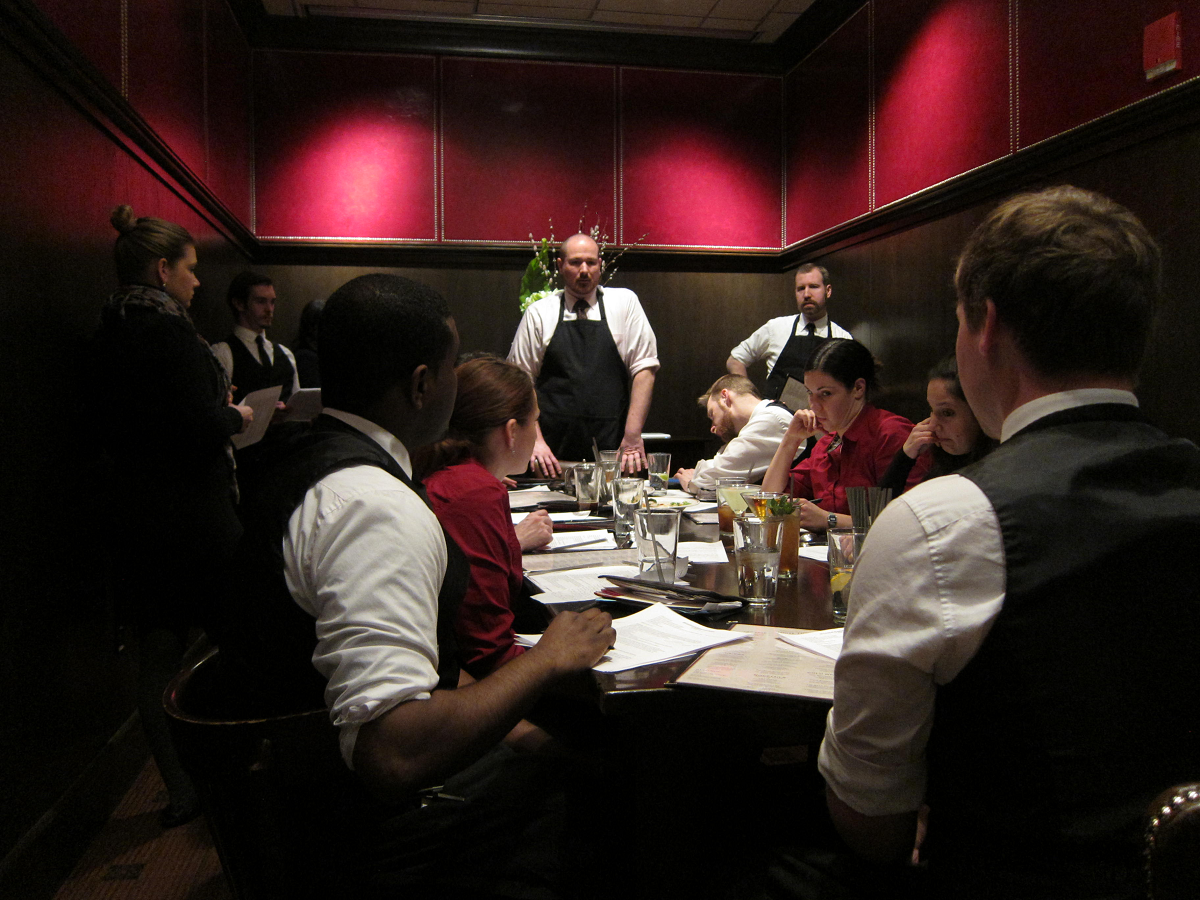
ES bar manager Kevin Martin (center) and “beverage program liason” Bob McCoy (right) lead the staff through cocktail menu additions. All photos by Leah Mennies.
Many restaurants in this city take hospitality and service quite seriously—but perhaps none quite as much or as famously as Eastern Standard, that stalwart in Kenmore Square that’s somehow found a way to feel relevant and special to a crazy-wide range of budgets and interests. A big reason that the 220-seat behemoth—with a front-of-house staff to match (about 50 total, including six full-time managers)—is able to accomplish this? An intensive amount of staff education on everything from specific dishes to current events to Massachusetts counties (the latter was, in fact, a past ES staff research project). This Saturday, February 8, the restaurant will be making some of its staff classes available to all by way of “Standard” Education Day, a program that allows the dining public to purchase tickets ($40 a class) and sit in on lectures and demos about everything from sherry to cheese to “raw foods” (oysters, crudos, etc.).
To get a first-hand look at the typical education of an ES staffer, I sat in on five consecutive days of 4 p.m. briefings in the restaurant’s private dining room. Here’s what I took away:
1. Forget about the NSA—Eastern Standard knows everything about you. Each day, briefings conclude with a rundown of what familiar faces to look out for in the dining room—from the VIP regular about to make his 325th visit (and orders “whiskey martinis” but really means “Rye Manhattans”) to the couple in for their seventh visit. “Each time a guest makes a reservation, a server is handed a slip with a piece of paper on it—it’s the server’s job to take notes on the diner’s experience, and hand in the slips at the end of the night,” says manager Deena Marlette, who organized “Standard” Education Day. “We keep track not only of their dining experience, but small things like ‘rescues beagles,’ in case a server comes across that and says, ‘I grew up with a beagle!’ It can create an extra level of interaction.” It can also make it incredibly convenient if you just can’t remember that awesome drink you effused to your server about the last time you visited.
2. ES may be known for cocktails, but it’s no slouch on wine. On Monday, sommelier Colleen Hein (who recently offered us some dessert wine suggestions) led the staff through a blind tasting of a wine that she felt had become a “sleeper” on the list. We each received a worksheet guiding us through the blind process, discussing the things to look for when analyzing everything from appearance to aroma to taste. Based on these notes, we had to pen our own description after getting the big reveal (2011 Larredya, ‘La Part Davant’ Jurancon from the Southwestern, or “Sud-Ouest” region of France). A sample description from a server named Remy: “A beautiful yellow-gold with an evanescent edge. Notes of honeysuckle, jasmine and pear abound on the nose. On the palate you get slight hints of cream, yeast, and fresh lemon with an assertive minerality. A medium body.” After penning formal descriptions, Hein discussed how to convert this newfound knowledge into a more-casual tableside manner. The best way to sample this diligence? On “Wine Cellar Mondays,” when the restaurant offers a special by-the-bottle menu starring wines with lower markups. (Sud-Ouest wines are also the focus of Hein’s class on Saturday.)
3. The staff is well-read. Each Wednesday, the staff discusses the dining sections of the Globe and the The New York Times, most specifically the columns of Devra First (dubbed “Queen Devra”), Pete Wells, and Eric Asimov. The week I sat in marked the one-star review of Back Bay Harry’s, which pointed out a couple of service errors at the restaurant. An ES server filled in the staff about one such error mentioned in the review—a server accidentally repeated the evening’s specials twice—and the entire private dining room groaned in response.
4. Their parlor games are serious… On Thursday, the staff played Jeopardy, with questions painstakingly crafted by manager EmmyLou Taylor and the score managed by bar manager Kevin Martin. It was intense, with categories divided into “Service,” “Food,” “Beer/Cocktail/Spirits,” “Wine,” and “Potpurri,” a current-events category with several references to past Wednesday readings. The staff divided into teams with names like “The Demitasse Spoons.”
A brief selection of questions:
Food
“A perennially flowering plant that has a coagulating effect on soft and hard cheeses.” (What is Thistle/Nettle?)
“This is also known as a filbert or cobb nut.” (Hazelnut)
“An animal that’s often breaded and fried, with a beak and quill that needs to be removed during prep.” (Squid—tricky!)Potpurri
“This state now requires cooks and bartenders to wear plastic gloves.” (California)
“This restaurant in Brookline recently received three stars from the Globe.” (Fairsted Kitchen)
“This renowned chef from the Midwest recently contemplated banning babies from his restaurant.” (Grant Achatz/Alinea)Service
“This ES regular walks with a cane and hates caramel sauce on desserts.” (Everyone knew the answer.)
“The dimensions of the tablecloth on Table 35.” (72’ x 72’)
5. …And so is cheese buyer Matt Baum. Each day, Baum runs through the evening’s cheese board selections. On Tuesday, he went into extended detail on a new-to-the-list cheese called Tobasi from Williamstown farm Cricket Creek, a Taleggio-style washed rind variety that’s buttery, creamy, and earthy. The following day, he discussed a French cheese called Prefere de nos Montagnes, a gooey, pungent offering that’s similar to a revered style—banned in the U.S. since it’s raw and not aged long enough to meet FDA mandates—called Reblochon. So that servers would feel comfortable discussing the similarities with diners, Baum also passed around a handout on Reblochon. It should also be noted that Baum was definitely the most intense Jeopardy player (and likely scored the most points), and a few days later, accidentally drove a ticket spike through his hand during service—and left the stack of meal tickets in place on the spike all the way to the emergency room.
6. Don’t skip the plats du jour. The kitchen rolled out a new lineup of weekly specials, or plats du jour, the week I sat in—so executive chef Patrick Campbell (formerly of No. 9 Park) and his sous chefs explained the new dishes in store, each of which was thoughtfully constructed and designed as a sizeable, value-driven plate of food. Since we were able to sample each, I can tell you that the one not to miss is Wednesday’s Champvallon, a French-style Shepard’s Pie of sorts that layers potatoes, onion soubise, red wine-braised lamb neck, and more thinly sliced potatoes in a hefty Staub crock. Allegedly, the pie is named for the mistress of Louis XIV, who used to make a version of the dish for him. But even more importantly, it’s gigantic and comforting, and comes with a bracing chicory and citrus salad for $24.
7. If you want to know what they learned today, ask! According to Marlette, the idea for offering “Standard” Education Day arose after several regulars would regularly quiz servers, with great interest, on what they learned in the day’s briefing. If you’d like to get in on the action, simply ask the next time you snag a bar seat. (And, for more in-depth detail, of course, purchase a class ticket).
